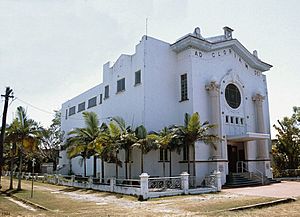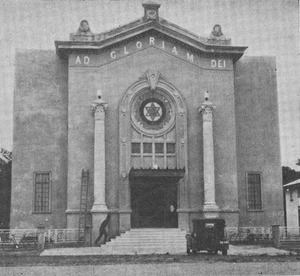Cairns Masonic Temple facts for kids
Quick facts for kids Cairns Masonic Temple |
|
|---|---|

Cairns Masonic Temple, 1994
|
|
| Location | 8 Minnie Street, Cairns, Cairns Region, Queensland, Australia |
| Design period | 1919 - 1930s (interwar period) |
| Built | 1934 - 1935 |
| Official name: Cairns Masonic Temple | |
| Type | state heritage (built) |
| Designated | 28 August 1998 |
| Reference no. | 601539 |
| Significant period | 1934-1935, 1957 (fabric) 1935- ongoing (social) |
| Significant components | furniture/fittings, fence/wall - perimeter |
| Lua error in Module:Location_map at line 420: attempt to index field 'wikibase' (a nil value). | |
The Cairns Masonic Temple is a special old building in Cairns, Queensland, Australia. It's located at 8 Minnie Street. This building is important because of its history and design. It was built between 1934 and 1935. Today, it is listed on the Queensland Heritage Register, which means it's protected for future generations.
Contents
The Story of the Cairns Masonic Temple
This two-storey concrete building was finished in 1935. It was the third building in Cairns used by a group called the Freemasons.
Early Days of Freemasonry in Cairns
The first time Freemasons met in Cairns was in December 1885. They gathered at Hides Hotel. The first Masonic group, called Gregory Lodge No. 50, officially started in April 1886. By the mid-1920s, six different Masonic groups met in Cairns. They used a building on Lake Street. Before a big storm (cyclone) destroyed that building in 1927, the groups moved. They went to a building next to where the current Temple stands today.
Creating a District Grand Lodge
In 1921, the Gregory Lodge decided to ask for a larger group. They wanted a "District Grand Lodge" (DGL) for the Carpentaria area. This DGL would be based in Cairns. The main Masonic group approved this idea in December 1923. The DGL of Carpentaria officially formed in 1924. Its area stretched from Cardwell to Cape York. It also went west to Normanton.
Building a Memorial Temple
In 1928, the DGL decided to build a special memorial. It would honor people who helped during World War I. It would also celebrate the peace that followed. The next year, they asked for donations to build this "Memorial Temple." In 1934, they decided to go ahead with the building. It would cost about £12,000 and be built next to their current hall.
Designing and Building the Temple
Architects Hill and Taylor designed the new Masonic Temple. They had offices in Townsville and Cairns. Richard Hill and Arthur Taylor started their firm in Cairns in 1927. The builder was CE Steadman. Both the architects and the builder were Freemasons.
The first stone of the building was laid on Armistice Day in 1934. This day remembers the end of World War I. People called the building the "Masonic Peace Memorial Temple." They said it would be a "fitting memorial" to those who helped during the war. They chose Armistice Day because it stood for peace and harmony.
The Temple was built during a time when Cairns was being rebuilt. Many buildings in the city center were new. This happened partly because of strong cyclones in 1920 and 1927. Cairns was also growing as an important city in Far North Queensland.
Dedication and Features
The Temple was officially opened in October 1935. Sir Leslie Orme Wilson, the Governor of Queensland, led the ceremony. He was also a Masonic Grand Master. About 700 Freemasons from all over Queensland attended.
The building had an impressive front facing Minnie Street. Inside, it featured beautiful wood from North Queensland, like walnut and maple. The building was also designed to stay cool. It had special air ducts and fans to keep fresh air flowing. This was important for Cairns' humid weather.
In 1954, a special plaque was placed. It honored WHJ Mayers, who was the first District Grand Master.
Repairs and New Pillars
In March 1956, a cyclone damaged the Temple. The two large pillars at the entrance were broken. Windows and other parts of the building were also damaged. New pillars were finished in 1957. Following Masonic tradition, these new pillars were hollow. Copies of important records were placed inside one of them.
What the Temple Looks Like
The Masonic Temple is a two-storey building made of concrete. It has a gable roof hidden behind a flat top wall called a parapet. The building is shaped like a "T." The main entrance faces Minnie Street.
The front of the building is very grand and balanced. It has a set of stairs leading to a door. Above the door is a tall, rounded arch. On each side of the arch is a Corinthian column. These columns support a large globe. Each column sits on a base with a marble plaque. The arch has a large keystone at the top. Below the keystone are a round window and four small square windows. The parapet wall has the words "AD GLORIAM DEI" (meaning "To the Glory of God"). On top of the parapet is the Masonic symbol. This symbol shows a carpenter's square and a divider.
The sides and back of the building have high windows. These windows are made of steel frames with many small glass panes. There are also entrance doors on the sides and at the back.
Inside, the building has a large hall. There is also a balcony (gallery). Staircases lead to the first floor at the front and back.
The front of the building on Minnie Street has an iron fence with concrete posts.
Why the Temple is Important
The Cairns Masonic Temple was added to the Queensland Heritage Register on 28 August 1998. This means it is recognized as a special place for a few reasons:
Showing Queensland's History
The Masonic Temple was completed in 1935. Since then, it has been the main meeting place for Freemasons in Far North Queensland. The Temple shows how Cairns grew into an important regional city in the early 1900s.
Its Beautiful Design
The Masonic Temple has a striking and unique front. This design makes it stand out in Cairns. The building's look, size, and shape make it a well-known landmark in the city.


